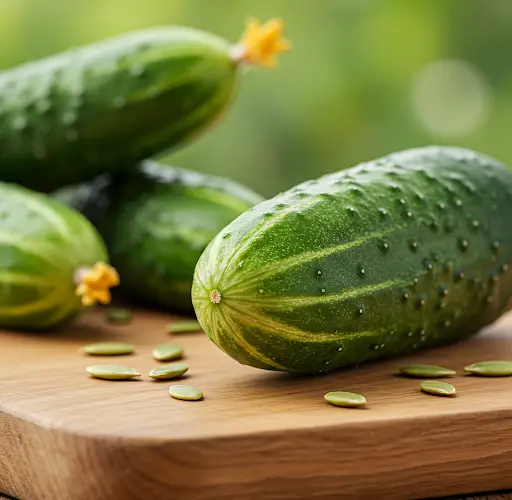Stop Buying Cucumbers! The Secret to Growing Cucumbers Year-Round at Home
Cucumbers are a refreshing and versatile vegetable, perfect for salads, pickles, and even smoothies. But instead of buying them from the market, wouldn’t it be great to have a year-round supply of fresh, organic cucumbers right at home?
With the right techniques, you can grow cucumbers continuously throughout the year, whether you have a garden, balcony, or even a small indoor space. This guide will reveal the secrets to cultivating cucumbers successfully, ensuring a bountiful harvest in any season.
Why Grow Cucumbers at Home?
Growing cucumbers at home has numerous benefits:
- Fresh and Organic: Enjoy pesticide-free, garden-fresh cucumbers whenever you need them.
- Cost-Saving: Save money by growing your own cucumbers instead of purchasing them regularly.
- Continuous Harvest: With the right setup, you can have cucumbers growing year-round.
- Space-Saving Options: Cucumbers can be grown vertically, in containers, or hydroponically, making them ideal for any home setup.
- Better Taste & Nutrition: Homegrown cucumbers are crisper, more flavorful, and more nutritious than store-bought ones.
Now, let’s dive into the step-by-step process of growing cucumbers at home throughout the year.
Step 1: Choosing the Right Cucumber Varieties
To ensure success in growing cucumbers year-round, selecting the right variety is crucial. There are two main types of cucumbers:
- Bush Cucumbers: Ideal for containers and small spaces, such as patio or indoor gardening.
- Vining Cucumbers: These require trellises or vertical support and tend to produce more cucumbers per plant.
Best Varieties for Year-Round Growing:
- Persian Cucumbers: Small, seedless, and perfect for indoor or greenhouse growing.
- English Cucumbers: Thin-skinned, mild flavor, and thrives in hydroponic or container setups.
- Pickling Cucumbers: Great for those who love making homemade pickles.
- Burpless Cucumbers: Low in bitterness and easy to digest.
Choose a variety that best suits your growing space and personal preference.
Step 2: Preparing the Perfect Growing Environment
Cucumbers thrive in warm, sunny, and well-ventilated conditions. To grow them year-round, you need to provide the right environment, whether indoors or outdoors.
Outdoor Growing Conditions:
- Sunlight: At least 6–8 hours of direct sunlight per day.
- Temperature: Ideal range is 70–85°F (21–29°C).
- Soil: Well-draining, rich in organic matter with a pH of 6.0–6.8.
- Support: Use trellises for vertical growth to save space and improve air circulation.
Indoor or Greenhouse Growing Conditions:
- Artificial Light: If natural sunlight is insufficient, use LED grow lights for 12–16 hours daily.
- Temperature Control: Maintain warmth using heaters or insulation in winter.
- Ventilation: Ensure good airflow to prevent mold and pests.
- Hydroponic or Container Gardening: A great option for indoor spaces with limited soil.
Step 3: Planting Cucumbers for Maximum Yield
Seed Starting:
- Germination: Start cucumber seeds in small pots indoors, 2–3 weeks before transplanting.
- Depth: Plant seeds ½ inch deep in moist, well-draining soil.
- Spacing: Space plants 12–18 inches apart for proper growth.
- Transplanting: Once seedlings have at least two sets of leaves, transplant them to larger containers or garden beds.
Container Growing Method:
If growing cucumbers indoors or on a balcony, use:
- Large Pots (at least 5 gallons) per plant.
- Good Drainage to prevent root rot.
- Vertical Support such as stakes or cages.
Step 4: Caring for Your Cucumber Plants
Proper care ensures continuous cucumber production throughout the year.
1. Watering:
- Consistent Moisture: Cucumbers are 80–90% water, so keep the soil evenly moist but not soggy.
- Best Time to Water: Early morning or late afternoon to prevent evaporation.
- Drip Irrigation: Ideal for preventing fungal diseases and keeping leaves dry.
2. Fertilizing for Maximum Growth:
- Use a balanced fertilizer (10-10-10 or 5-10-10) every 2 weeks.
- Compost or Organic Fertilizers (like fish emulsion or seaweed extract) can boost growth naturally.
3. Pruning and Training Vines:
- Remove damaged or overcrowded leaves for better airflow.
- Train vines on a trellis for easier harvesting and improved fruit quality.
4. Pollination:
- Outdoor Plants: Bees and other pollinators help naturally.
- Indoor Plants: Use a small brush to hand-pollinate flowers or choose self-pollinating varieties.
Step 5: Harvesting Cucumbers Year-Round
- When to Harvest: Cucumbers are ready in 50–70 days after planting.
- How to Harvest: Use scissors or pruners to cut cucumbers from the vine.
- Frequent Harvesting: Picking cucumbers regularly encourages more production.
For the best taste, harvest cucumbers when they are firm, dark green, and about 6–8 inches long.
Step 6: Extending Your Cucumber Season
To keep growing cucumbers all year:
- Succession Planting: Start new cucumber plants every 4–6 weeks to maintain a continuous supply.
- Greenhouse or Indoor Gardening: Allows for temperature control and protection from extreme weather.
- Winter Protection: Use row covers or cold frames to grow cucumbers in cooler months.
Bonus Tip: Hydroponic Cucumber Growing for Maximum Yield
Hydroponic systems allow cucumbers to grow faster and in greater quantities without soil. Benefits include:
- Faster growth rates and higher yields.
- Less risk of pests and soil-borne diseases.
- Can be set up indoors with grow lights.
Using deep water culture (DWC) or nutrient film technique (NFT), you can grow cucumbers in water-rich nutrients year-round.
Final Thoughts
With the right techniques, anyone can grow cucumbers at home year-round. Whether using containers, raised beds, or hydroponics, you can enjoy a continuous harvest of fresh, crunchy cucumbers without ever stepping into a grocery store.
By providing the ideal growing conditions, proper care, and consistent replanting, you’ll never have to buy cucumbers again. Start your year-round cucumber garden today and experience the joy of homegrown produce!



